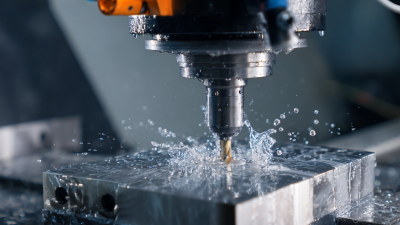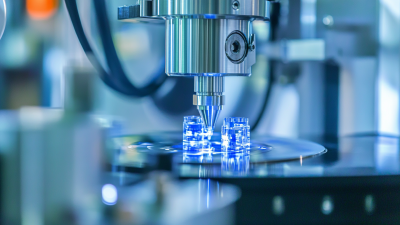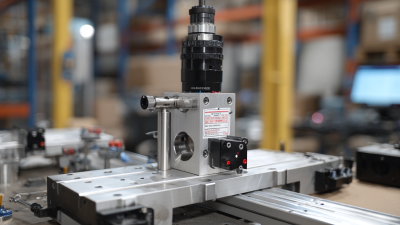

In the ever-evolving landscape of manufacturing, the significance of CNC fixtures cannot be overstated. These tools are critical in ensuring precision, efficiency, and repeatability in machining processes, thus playing a vital role in reducing production costs and enhancing productivity. As the industry embraces advanced technologies such as automation and IoT, the future of CNC fixture design is bound to transform.

Renowned CNC fixture expert, Dr. Emily Harper, emphasizes the importance of this evolution: "The future of CNC fixture design lies in its ability to simplify complex processes while maximizing operational efficiency." Her insight highlights the urgent necessity for manufacturers to rethink their fixture strategies in response to changing demands and technological advancements. With a focus on versatility and customization, the next generation of CNC fixtures is set to redefine manufacturing workflows, enabling greater flexibility and faster turnaround times.
As we delve deeper into the exploration of CNC fixture design and its implications for manufacturing efficiency, it becomes increasingly clear that staying ahead of the curve is essential. The synergy between innovative design and manufacturing processes will likely dictate the competitive landscape in the coming years, making it imperative for industry players to invest in the future of CNC fixtures.
CNC fixture design is undergoing a transformative evolution, driven by advancements in materials, automation, and modular workholding solutions. As manufacturing demands increase, the trend towards integrating advanced materials and digital processes into fixture design allows for greater efficiency and adaptability. The shift to modular workholding not only simplifies the setup process but also reduces costs by enabling manufacturers to use standardized components that can be easily reconfigured for different tasks.
Tips: When considering new CNC fixture designs, investigate the incorporation of modular components. This approach not only streamlines the setup and changing processes but also improves manufacturing flexibility.
Moreover, the rising trend of automatic scanning measurement technologies is enhancing the precision and speed of machining operations. As manufacturers begin to adopt these optical measurement systems, they can achieve better quality control and more precise fitting of components, ultimately boosting overall manufacturing efficiency.
Tips: Embrace optical measurement technologies in your workflows. This integration will help in maintaining high-quality standards while meeting the increasing production demands in the competitive manufacturing landscape.
The evolution of CNC fixture design is heavily influenced by the introduction of
innovative materials, which directly contribute to improvements in
manufacturing efficiency. Advanced materials such as
carbon fiber composites, lightweight alloys, and
smart polymers are being integrated into fixture solutions,
enabling manufacturers to achieve greater precision and durability. These materials not only reduce the overall
weight of fixtures, facilitating faster setups and adjustments, but also enhance the strength-to-weight ratio,
allowing for more robust support during machining processes.
In addition, the application of intelligent materials that can adapt
to varying conditions brings a new dimension to fixture design. For instance,
thermochromic and
piezoelectric materials can change their properties in response
to temperature variations or mechanical stress, providing real-time feedback and adjustment capabilities. This adaptability
ensures that fixtures remain optimal for high-precision tasks, minimizing
downtime and maximizing productivity. Furthermore, the sustainability aspect of innovative materials cannot be
overlooked; by opting for eco-friendly alternatives,
manufacturers are also aligning with global trends toward responsible production practices. Through these advancements,
the future of CNC fixture design looks promising, with a solid focus on efficiency
and effectiveness in manufacturing processes.
The integration of smart technology in CNC fixture development is revolutionizing the manufacturing landscape. Smart technologies such as IoT sensors, machine learning algorithms, and advanced data analytics are being incorporated into CNC fixtures, enabling real-time monitoring and adaptive responses to production conditions. This level of connectivity allows manufacturers to optimize tooling setups, reducing downtime and enhancing precision. As fixtures become smarter, they can self-adjust based on various factors, including workload and material properties, which leads to improved operational efficiency and reduced waste.
Moreover, the integration of smart technology facilitates predictive maintenance, which is crucial for minimizing interruptions in the production process. By monitoring the condition of CNC fixtures and predicting potential failures, manufacturers can schedule maintenance proactively, thereby decreasing the risk of unexpected breakdowns. This transformative approach not only maximizes productivity but also ensures higher quality outputs, as the smart fixtures can provide consistent and accurate positioning. The future of CNC fixture design, underpinned by these advancements in smart technology, promises not only enhanced efficiency but also a significant leap towards automation and smart manufacturing ecosystems.
Modern fixture design is revolutionizing manufacturing efficiency, significantly impacting production processes across various industries. According to a report by SME (Society of Manufacturing Engineers), the implementation of advanced CNC fixtures can lead to a 20-30% increase in production speed. This acceleration is largely attributed to better automation and precision, which minimize the need for manual setups and adjustments. Consequently, manufacturers can redirect resources and time toward core production activities, enhancing overall throughput.
Moreover, the flexibility offered by contemporary fixture designs plays a crucial role in optimizing production. A study by Deloitte highlights that factories utilizing modular and adaptive fixtures can respond to varying production demands more effectively, reducing downtime and material waste by up to 25%. These fixtures can be quickly reconfigured for different tasks, allowing businesses to pivot rapidly in response to market changes. As manufacturers embrace innovative fixture solutions, the drive for efficiency not only streamlines operations but also contributes to higher quality outputs, ensuring a competitive edge in a rapidly evolving marketplace.
The integration of advanced CNC fixture design in manufacturing has shown promising results, as evidenced by various case studies across different industries. Companies that have adopted sophisticated CNC fixtures report significant improvements in operational efficiency and production accuracy. These advancements not only streamline the machining process but also enhance product quality and reduce material waste. For instance, one company successfully implemented adjustable CNC fixtures that allowed for quick setup changes, decreasing downtime and increasing throughput.
Furthermore, the adoption of intelligent robotics in manufacturing processes complements these CNC advancements. As robotics technology evolves, the synergy between CNC fixtures and robotic systems can further push the boundaries of efficiency in production lines. By allowing for real-time adjustments and automation in tasks that were previously manual, businesses can achieve a level of precision and scalability that was once unattainable. As industries continue to explore these innovative solutions, the potential for optimizing manufacturing processes and meeting consumer demands is substantial.






